If you’re one of the millions of people suffering from rhinitis (hay fever), you know that the symptoms can be debilitating. Sneezing, runny nose, itchy eyes and sore throat; it’s enough to make anyone want to hide indoors until springtime is over.
But there’s no need to suffer! There are a number of Ayurvedic natural ways to fight hay fever and get relief from your symptoms.
A holistic system of medicine, Ayurveda helps to reduce the severity of the rhinitis symptoms and supports body’s natural ability to heal with herbal medicines, diet and lifestyle changes.
Ayurvedic treatment for allergic rhinitis focuses on reducing inflammation, boosting immunity and relieving the symptoms at the root cause level.
In this post, you will gain better understanding of symptoms and causes of allergic rhinitis. You will also learn about Ayurvedic holistic treatment for allergic rhinitis.
What is Allergic Rhinitis?
Allergic rhinitis, also known as hay fever, is a condition that causes the nose and airways to become inflamed and irritated. Symptoms include sneezing, runny nose, itchy and watery eyes, sore throat and nasal congestion.
Hay fever is usually triggered by an allergic reaction to airborne allergens such as pollen, dust mite, temperature change, pollutants or pet dander.
Allergic rhinitis is a very common condition related to inflammation in the nasal passage and allergies in the respiratory system. It affects up to 30% of the world’s population.
Allergic Rhinitis is known as Vata Kaphaja Pratishaya in Ayurveda.
Types of Allergic Rhinitis
There are two main types of allergic rhinitis: seasonal allergy and perennial allergic rhinitis.
- Seasonal Hay fever: It usually gets aggravated during the Vata times of the year, which is spring, summer, and early fall. This is commonly termed as the seasonal allergy.
- Perennial Hey fever: Some people suffer from allergic rhinitis throughout the year, which is commonly termed as perennial allergic rhinitis. Usually, chronic rhinitis symptoms are aggravated at Vata times during the day, which is from 2 AM to 6 AM and from 2 PM to 6 PM.
Non Allergic Rhinitis
Unlike allergic rhinitis, which is triggered by an allergen, non-allergic rhinitis does not have a specific trigger. However, there are several factors that can contribute to the condition, including environmental irritants, changes in weather, medications, and hormonal imbalance.
Both allergic rhinitis and non allergic rhinitis exhibit similar symptoms as sneezing, congestion, and runny nose. While non-allergic rhinitis is not a serious condition, it is annoying and disruptive.
Ayurvedic Perspective of Allergic Rhinitis
According to Ayurveda, primary causes of Vata Kaphaja Pratishaya is poor digestion and toxin build up in the Rasa Dhatu and Rakta Dhatu (plasma and blood tissues) in the body.
Along with toxin build up, Vata Dosha Imbalance and Kapha Dosha Imbalance are usually present in Pratishaya. While Kapha Dosha imbalance leads to development of excessive mucus in the body, Vata Dosha imbalance further leads to blockade and irregular movement of the mucus through the body orifices.
Listed below are some of the causes that lead to Dosha Imbalance and Toxin build-up in the body:
- Regular consumption of incompatible foods.
- Wrong dietary habits that slow down the digestive fire and build up toxins in the body.
- Regular consumption of cold, frozen, processed, and stale foods.
- Regular consumption of Kapha increasing foods.
- Holding off to natural urges such as urination, defecation, belching, sneezing, and passing of gas.
- Exposure to very cold or very hot weather and strong winds.
- Irregular and inconsistent meal times and sleep cycle.
- Excessive travel and or excessive stress.
Risk Factors and Allergens that Trigger Allergic Rhinitis Symptoms
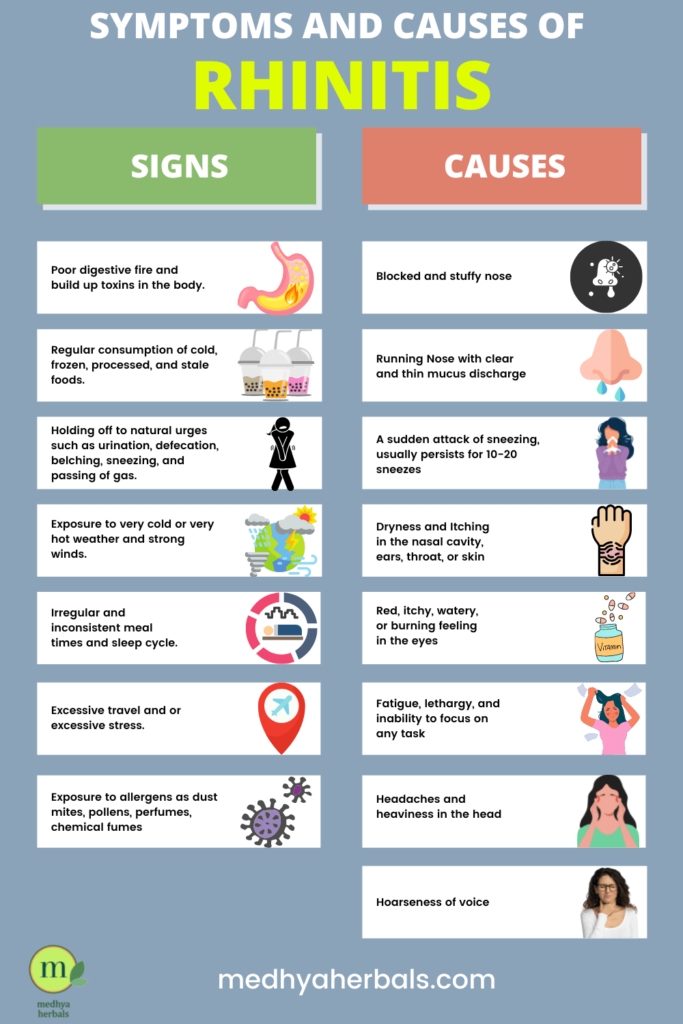
Allergic Rhinitis is usually triggered by prolonged or significant exposure to some of the commonly occurring substances such as:
- Dust mites present on carpets, curtains, sofa covers, and mattress etc.
- Animal/Pet dander
- Insect droppings
- Mold present in different corners of the common places where you spend considerable amount of time
- Pollen from grass, trees, and plants
- Perfumes and certain strong smells
- Sudden change in temperature and or humidity levels
- Chemical fumes from cleaning products, personal care products, and fumigation
- Certain food items, specifically ones that are loaded with artificial food colours and preservatives
Symptoms of Allergic Rhinitis
When your body comes in contact with the stated or other allergens, it considers them a threat. Hence, your immune system releases chemicals such as histamine flooding your sinuses, nasal cavity, and other body parts that have come in contact, to flush out the foreign particles.
This leads to the typical allergic rhinitis symptoms faced by the patients:
- Blocked and stuffy nose
- Running Nose or Postnasal Drip with clear and thin mucus discharge
- A sudden attack of sneezing, usually persists for 10-20 sneezes
- Dryness and Itching in the nasal cavity, ears, throat, or skin
- Red, itchy, watery, or burning feeling in the eyes
- Fatigue, lethargy, and inability to focus on any task. This primarily results from lack of rest experienced due to ongoing allergic rhinitis symptoms.
- Headaches and heaviness in the head
- Hoarseness of voice
Ayurvedic Treatment for Allergic Rhinitis
Ayurvedic treatment for chronic rhinitis involves detoxification to flush the toxin build up in the respiratory tract, clearing the sinus by expelling the phlegm, immunity support and strengthening of the upper respiratory tract to prevent and heal rhinitis.
Panchakarma therapies are carried out in cases of chronic rhinitis and allergic symptoms. Nasal drop therapy or Nasya can be administered under the supervision of an Ayurvedic doctor for mild to moderate severity of symptoms.
Ayurvedic treatment for hay fever generally includes a combination of lifestyle changes, dietary modifications, and herbal remedies. These measures can help to reduce the severity of symptoms and improve quality of life.
Some of the most effective Ayurvedic treatments for hay fever include:
Ayurvedic Medicine and Natural Remedies for Hay fever
One of the best ways to treat allergic rhinitis, or hay fever, is through the use of Ayurvedic herbs. There are a number of different herbs that can be used to effectively treat hay fever, and many of them are readily available at your local health food store.
Some of the most effective Ayurvedic herbs for treating hay fever include:
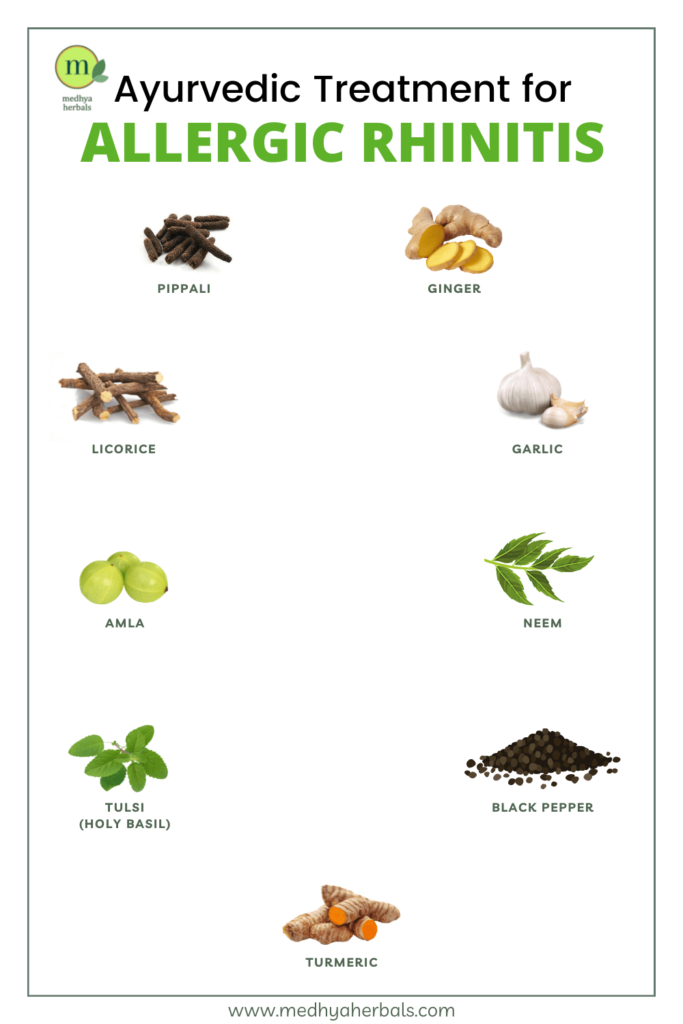
Amla: Also known as Indian gooseberry, Amla is one of the mot popular Ayurvedic medicine for treating hay fever. It is the richest source of vitamin C and possesses anti-inflammatory and antihistamine properties.
Guduchi: Guduchi has immunomodulatory properties that helps to reduce the severity of hay fever symptoms. It can be taken in capsule form or as a tea.
Licorice root: Licorice root is an excellent Ayurvedic remedy for treating hay fever because it helps to reduce inflammation in the respiratory tract, soothes the mucus lining and calms the immune system. It can be taken in capsule form or as a tea.
Turmeric: Turmeric is common home remedy that has anti inflammatory, anti microbial and healing properties. It can be taken in capsule form or as a spice in food.
Tulsi: Tulsi is an Ayurvedic herb that has a long history of use for treating a variety of conditions, including hay fever. It can be taken in capsule form or as a tea.
Ginger: Ginger relieves the symptoms of allergic rhinitis and works pretty much like an antihistamine medication. It helps to reduce inflammation, soothes immune system and heal the mucus lining in the respiratory tract.
Ayurvedic Diet for Treatment of Rhinitis
Since the primary cause of Allergic Rhinitis is toxin build up in the body, one needs to mindfully keep all the incompatible and unnatural foods away. Additionally, it is highly important to follow healthy diet habits that support good digestion and protect your digestive fire.
In terms of food and lifestyle, one needs to follow a Vata and Kapha pacifying diet and lifestyle. Some of the ground principles are:
- Fix your meal times and sleep timings. This is one of the primary steps towards balancing Vata Dosha.
- Take an early dinner that is light and easy to digest.
- Keep biggest meal of the day for the lunchtime and always take lunch between 12 – 2 Pm when your digestive fire is at its peak.
- Avoid heavy to digest dairy foods such as old cheese, sheep’s milk cheese, and buffalo mozzarella.
- Eliminate foods with a cold potency and cold temperature such as cold and frozen foods or drinks, and carbonated drinks.
- Remove salty, stale, heavily processed foods, and ready cooked meals. Avoid, leftovers from the refrigerator or freezer.
- Always prefer seasonal and freshly cooked vegetables. Remove raw vegetables and salads from the diet.
- Take warm, unctuous, and lightly cooked meals in the form of steamed and stir-fried preparations.
- Increase intake of toning and digestive herbs such as ginger, turmeric, coriander, mint, thyme, basil, rosemary, black pepper, cumin, fennel, and carom seeds.
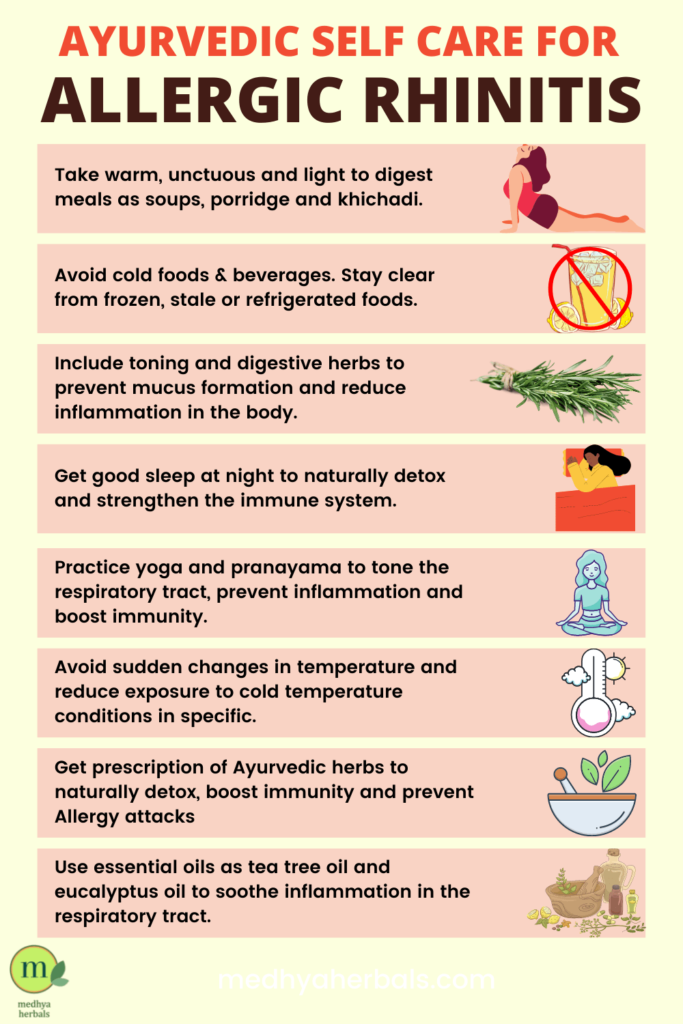
Ayurvedic Lifestyle to Treat Allergic Rhinitis
- Practice regular self-massage by warming oils such as sesame oil and ghee. In Ayurveda, it is known as Abhyanga.
- Practice Anuloma Viloma Pranayama or alternate nostril breathing for 10-15 mins on daily basis. It should be done early in the morning and before sleeping, but never after food intake.
- Apply pure sesame oil to the nostrils, termed as Nasya in Ayurveda before you sleep and after you get up.
- Do light and relaxing physical activity such as walking, jogging, swimming, yoga, dancing, and tai chi etc.
- Avoid sudden exposure to the Sun after prolonged stay in a cold temperature, for example air conditioned room.
- Take shower with normal temperature water and avoid pouring very hot and very cold water on your head.
Yoga and Pranayama for Allergic Rhinitis Treatment
Yoga and pranayama are very effective in the treatment of allergic rhinitis. Yoga helps in reducing the intensity of symptoms like sneezing, congestion, watery eyes, etc. Pranayama helps in improving the functioning of the respiratory system and also helps in reducing stress and anxiety.
There are a number of yoga poses and pranayama that can be helpful in treating allergic rhinitis or hay fever.
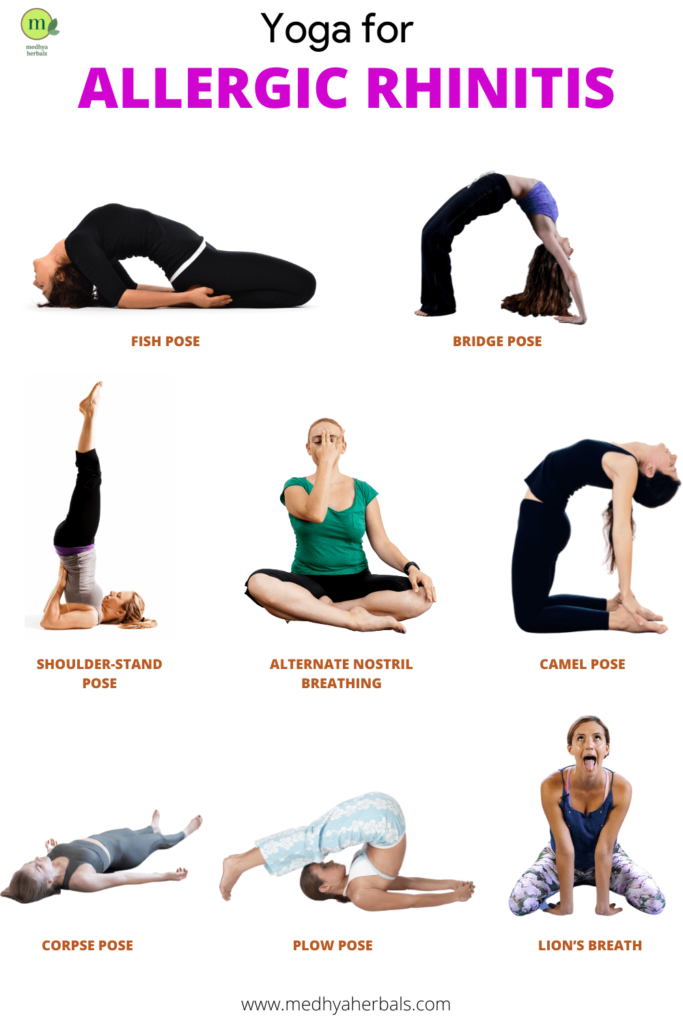
- Fish Pose: It helps to open up the sinuses and relieves congestion.
- Camel Pose: It stretches the throat and helps to clear the airways.
- Lion’s Breath: Breathing exercises and pranayama are also very beneficial in treating hay fever. The Lion’s Breath is particularly helpful in clearing the nasal passages.
- Corpse Pose: It is a great relaxation pose that can help to reduce stress and anxiety, both of which can trigger hay fever symptoms.
- Plow Pose: This pose is helpful in relieving sinus congestion.
- Bridge Pose: The Bridge Pose helps to open up the chest and lungs and is very beneficial in relieving the symptoms of hay fever.
- Alternate Nostril Breathing: This is a very effective pranayama for treating hay fever. It helps to clear the nasal passages and also helps to reduce stress and anxiety.
- Shoulder-Stand Pose: This pose is very helpful in relieving the symptoms of hay fever. It helps to open up the chest and lungs and also helps to reduce stress and anxiety.
Detoxification and Healthy Practices to Prevent Allergic Rhinitis
To treat the health condition one needs to identify the level of toxin build up in the body. Once, an assessment is made, toxins should be systematically removed from the body systems, where they have accumulated over time.
Some of the common steps to take are:
- Do a full body cleanse. Required intensity of the cleanse would depend on your body type and your current health condition.
- Carry out seasonal cleanse during spring, summer and fall to avoid seasonal allergic rhinitis.
- Perform regular short cleanses on weekly or monthly basis.
- Intermittent Fasting can also be practiced to prevent toxin build up in the body.
Remove the Allergens from Your Environment and Foods
One of the simplest yet inconsistent approach is to remove the triggers that lead to the symptoms of allergic rhinitis. For this, one needs to identify the specific allergens that they are most sensitive to. Once, this process is complete, carefully eliminate the allergens from your surroundings.
Some of the common steps to take are:
- Regularly clean the clothing around you such as bed sheets, curtains, sofa covers, and office clothing.
- Restrict the pets to certain areas of your home. This will help to control animal/pet related allergens.
- Control the indoor molds by cleaning bathtubs and shower area on frequent basis.
- Avoid outdoor pollens and environmental pollutants.
- Wear a simple mask to avoid exposure to dust.
- Maintain low humidity in common areas. It will help to keep down fungal invasion.
- Treat windows, shower curtains and indoor plants with mild fungicides.
- Keep a check on cockroaches and rodents.
Takeaway
Ayurvedic treatment for rhinitis is an effective way to remove the root cause and treat low immunity. Ayurvedic remedies start showing improvement within a few days. Ayurveda for allergic rhinitis offers a lasting cure for this respiratory disease.
FAQ
1. How do you fight hay fever naturally?
Hay fever, also known as allergic rhinitis, is a condition that affects millions of people worldwide. Symptoms include sneezing, itchiness, and runny nose. Hay fever can be a nuisance, but there are ways to fight it naturally. One way is to take advantage of the power of spices. Spices such as ginger, cloves, and turmeric have anti-inflammatory properties that can help to reduce hay fever symptoms. Another way to fight hay fever naturally is to drink plenty of fluids. This will help to flush out the allergens from your system. Finally, make sure to get plenty of rest. This will help to boost your immune system and help your body fight off the allergens more effectively. By following these simple tips, you can enjoy the summer months without fear of hay fever symptoms.
2. Can Ayurveda cure hay fever?
The use of Ayurveda for the treatment of hay fever dates back thousands of years. According to Ayurvedic principles, hay fever is caused by an imbalance of the body’s three doshas: Vata, Pitta, and Kapha. By restoring the balance of the doshas, Ayurveda can provide relief from the symptoms of hay fever, including sneezing, itching, and watery eyes. In addition, Ayurveda can help to prevent hay fever by strengthening the immune system and reducing inflammation. If you are suffering from hay fever, I encourage you to give Ayurveda a try. With its gentle and natural approach, it offers a safe and effective way to find relief from this troublesome condition.
3. What is the fastest way to treat allergic rhinitis?
The fastest way to treat allergic rhinitis is through a combination of allergen avoidance, Ayurvedic herbal medicines, and immunity boosting therapies. Allergen avoidance involves staying away from substances that trigger the allergic response. Herbal medications can be used to relieve symptoms and prevent exacerbations.
Ayurvedic immunotherapy helps to desensitize the individual to the allergens. It involves immunity supporting Ayurvedic medicines, diet and lifestyle changes.
These treatments can be used alone or in combination to provide the best relief possible. However, it is important to consult with an Ayurvedic practitioner to determine which approach is best for you.
4. Can allergy be cured by Ayurveda?
Allergies are caused when the body’s immune system overreacts to a foreign substance, such as pollen, pet dander, or peanut butter. The immune system releases chemicals, such as histamine, that cause allergy symptoms.
While there is no cure for allergies, there are many ways to treat the symptoms. Ayurveda is an ancient system of medicine originating in India that uses a holistic approach to health.
One of the goals of Ayurveda is to cleanse and detoxify the body, which can help to reduce the severity of allergy symptoms. Ayurvedic treatments can include dietary changes, herbs, and massage. Some people also find relief from yoga and meditation.
Ayurvedic treatment is personalised to an individual’s needs. Thus, it helps to effectively reverse allergies through personalised Ayurvedic medicines, diet plan and yoga practices. This provides an effective way to manage allergic rhinitis symptoms and improve overall health.
5. How does Allergic Rhinitis develop in the body?
Here is what happens when toxins start accumulating in your body.
- Poor digestive fire or “Mandagni” leads to build up of toxins or “Ama” in the form of undigested food particles and food wastes in the body.
- As toxin level builds up inside the digestive tract, it is no longer able to hold them. This leads to toxin overflow out of the digestive tract and eventually to the body systems through the plasma and blood circulation.
- This leads to a stage, where our body cells are immersed in the toxin laden plasma and blood, which is thicker and unclear in nature.
- This masks the natural intelligence of our body cells and severely impacts the functioning of our immune system. It decreases our body’s immune response.
- Additionally, toxins also lead to sluggish circulation in the body. This further creates nutritional deficiencies in the short term and poor quality body tissues in the long term.
- A sluggish immune system is not able to distinguish between usually benign foreign particles such as pollen, dust, humid air, and perfumes etc.
- Hence, these commonly present substances turn into allergens for the patient, whose immune system starts to overreact, leading to allergic rhinitis symptoms.
6. Can hypothyroidism cause non allergic rhinitis?
Hypothyroidism is a condition in which the thyroid gland doesn’t produce enough thyroid hormone. This hormone helps to regulate the body’s metabolism. Hypothyroidism can cause a number of symptoms, including fatigue, weight gain, and skin dryness.
In some cases, it can also lead to non allergic rhinitis. This condition is characterized by congestion, sneezing, and a runny nose. While the exact cause of non allergic rhinitis is unknown, it is thought to be linked to an overactive immune system.
In people with hypothyroidism, the immune system is already working overtime to fight the effects of the reduced thyroid hormone levels. As a result, it may be more likely to overreact to environmental triggers, such as dust or pollen. If you have hypothyroidism and think you may also have non allergic rhinitis, talk to your Ayurvedic doctor about treatment options.
7. What is Ayurvedic treatment for non allergic rhinitis?
Non allergic rhinitis is a condition in which the person experiences recurrent episodes of sneezing and runny nose, but they are not caused by an allergy. Ayurveda, the traditional system of medicine from India, offers a number of treatments for this condition. One of the most important aspects of treatment is identifying the person’s dosha, or body type.
Each dosha responds to different treatments, so it is essential to get this step right. Once the dosha has been determined, a variety of Ayurvedic therapies can be used to treat the non allergic rhinitis. These may include massage, acupuncture, and herbal medicines.
Ayurveda is a holistic approach to medicine that takes into account the whole person, not just the symptoms of their condition. As such, it can offer a very effective treatment for non allergic rhinitis.
8. What causes non-allergic rhinitis?
Non-allergic rhinitis is a condition that leads to inflammation of the lining of the nasal passage. This can cause a range of symptoms, including nasal congestion, runny nose, and sneezing. Although it shares many similarities with allergic rhinitis, non-allergic rhinitis does not involve an immune response.
Instead, it is often caused by environmental factors, such as changes in temperature or air pollution. Other potential causes include viral infections, hormonal changes, and certain medications. In some cases, the exact cause of non-allergic rhinitis may be unknown. However, if you suffer from chronic symptoms, it is important to see a doctor so that they can rule out other potential causes and develop a treatment plan.

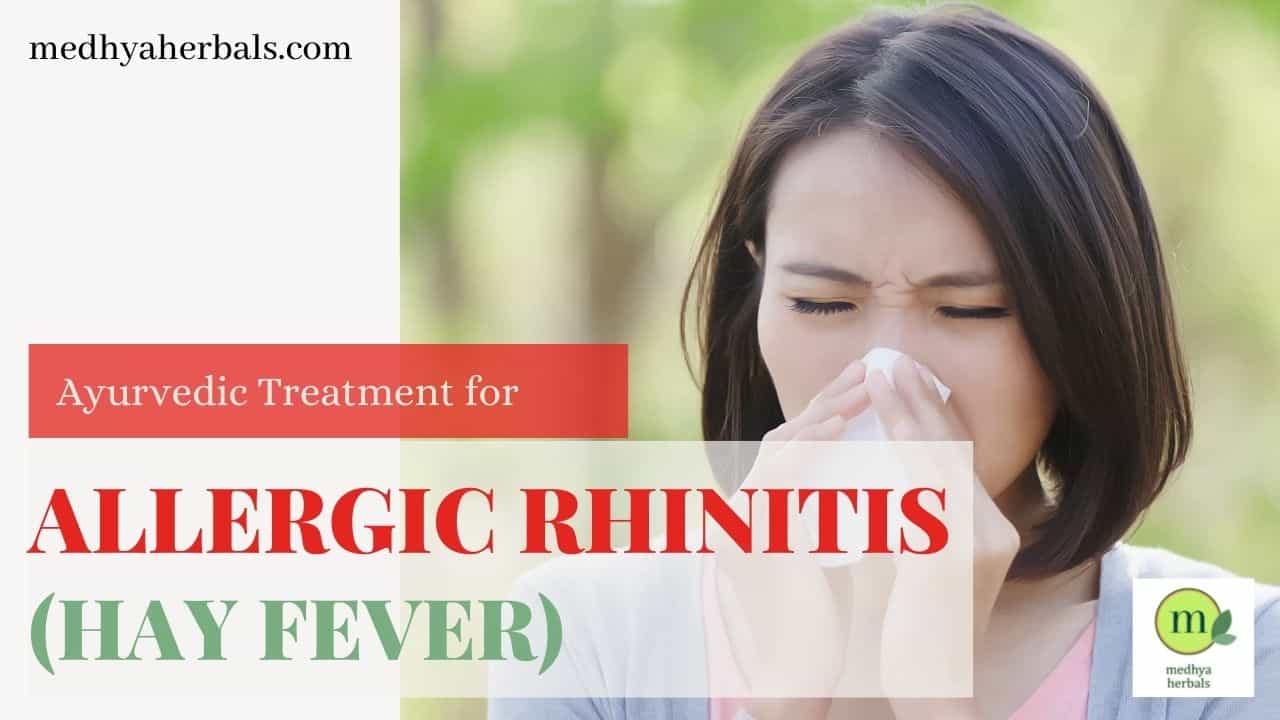
Can you help me with a ready made herbal remedy for allergic rhinitis…( cyre).
I'm in Nigeria
Hello! Allergic Rhinitis needs to be dealt with at the root cause by a deep body detox. However, regularly inhaling steam with essential oils, using nasal rinse (with warm water and little salt) and insertion of pure oil like coconut oil in the nostril (1 drop each at bedtime) can help.